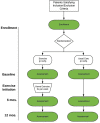Effectiveness of a Long-Term, Home-Based Aerobic Exercise Intervention on Slowing the Progression of Parkinson Disease: Design of the Cyclical Lower Extremity Exercise for Parkinson Disease II (CYCLE-II) Study
- PMID: 34363478
- PMCID: PMC8632855
- DOI: 10.1093/ptj/pzab191
Effectiveness of a Long-Term, Home-Based Aerobic Exercise Intervention on Slowing the Progression of Parkinson Disease: Design of the Cyclical Lower Extremity Exercise for Parkinson Disease II (CYCLE-II) Study
Abstract
Objective: Previous short duration studies have demonstrated that high-intensity aerobic exercise improves aspects of motor and non-motor function in people with Parkinson disease (PwPD); however, the effectiveness of a long-term exercise intervention on slowing disease progression is unknown. The primary aim of this study is to determine the disease-altering effects of high-intensity aerobic exercise, administered on an upright stationary cycle, on the progression of PD. A secondary aim is to develop a prognostic model for 12-month changes in the Movement Disorder Society Unified Parkinson's Disease Rating Scale III (MDS-UPDRS III) of PwPD undergoing an aerobic exercise intervention.
Methods: This pragmatic, multisite, single-rater blinded, randomized controlled trial will recruit PwPD from 2 large, urban, academic medical centers. Participants (N = 250 PwPD) will be randomized to (1) home-based aerobic exercise or (2) usual and customary care. Those in the aerobic exercise arm will be asked to complete in-home aerobic exercise sessions at 60% to 80% of heart rate reserve 3 times per week for 12 months utilizing a commercially available upright exercise cycle. The usual and customary care group will continue normal activity levels. Daily activity will be monitored for both groups throughout the 12-month study period. The primary outcome, both to assess disease-modifying response to aerobic exercise and for prognostic modeling in the aerobic exercise arm, is 12-month rate of change in the MDS-UPDRS III. Clinical and biomechanical measures will also be used to assess upper and lower extremity motor function as well as non-motor functions.
Impact: Should long-term aerobic exercise demonstrate disease-modifying capability, this study will provide evidence that "Exercise is Medicine" for PwPD. Further, the derived prognostic model will inform a patient-specific exercise prescription for PwPD and expected effects on PD progression.
Trial registration: ClinicalTrials.gov NCT04000360.
Keywords: Aerobic Exercise; Cycling; Exercise Prescription; Parkinson Disease.
© The Author(s) 2021. Published by Oxford University Press on behalf of the American Physical Therapy Association. All rights reserved. For permissions, please email: journals.permissions@oup.com.
Figures


Similar articles
-
Effectiveness of home-based and remotely supervised aerobic exercise in Parkinson's disease: a double-blind, randomised controlled trial.Lancet Neurol. 2019 Nov;18(11):998-1008. doi: 10.1016/S1474-4422(19)30285-6. Epub 2019 Sep 11. Lancet Neurol. 2019. PMID: 31521532 Clinical Trial.
-
Study in Parkinson's disease of exercise phase 3 (SPARX3): study protocol for a randomized controlled trial.Trials. 2022 Oct 6;23(1):855. doi: 10.1186/s13063-022-06703-0. Trials. 2022. PMID: 36203214 Free PMC article.
-
Design of the Park-in-Shape study: a phase II double blind randomized controlled trial evaluating the effects of exercise on motor and non-motor symptoms in Parkinson's disease.BMC Neurol. 2015 Apr 16;15:56. doi: 10.1186/s12883-015-0312-6. BMC Neurol. 2015. PMID: 25880966 Free PMC article. Clinical Trial.
-
The Universal Prescription for Parkinson's Disease: Exercise.J Parkinsons Dis. 2020;10(s1):S21-S27. doi: 10.3233/JPD-202100. J Parkinsons Dis. 2020. PMID: 32925109 Free PMC article. Review.
-
Current Perspectives on Aerobic Exercise in People with Parkinson's Disease.Neurotherapeutics. 2020 Oct;17(4):1418-1433. doi: 10.1007/s13311-020-00904-8. Neurotherapeutics. 2020. PMID: 32808252 Free PMC article. Review.
Cited by
-
Use of a Home-Based, Commercial Exercise Platform to Remotely Monitor Aerobic Exercise Adherence and Intensity in People With Parkinson Disease.Phys Ther. 2024 Feb 1;104(2):pzad174. doi: 10.1093/ptj/pzad174. Phys Ther. 2024. PMID: 38206881 Free PMC article. Clinical Trial.
-
The rise of Parkinson's disease is a global challenge, but efforts to tackle this must begin at a national level: a protocol for national digital screening and "eat, move, sleep" lifestyle interventions to prevent or slow the rise of non-communicable diseases in Thailand.Front Neurol. 2024 May 13;15:1386608. doi: 10.3389/fneur.2024.1386608. eCollection 2024. Front Neurol. 2024. PMID: 38803644 Free PMC article.
-
Feasibility and preliminary efficacy of an online home-based functional exercise program for Parkinson's disease: a pilot study.Front Neurol. 2025 Jun 23;16:1591330. doi: 10.3389/fneur.2025.1591330. eCollection 2025. Front Neurol. 2025. PMID: 40625903 Free PMC article.
-
Development and Evaluation of Wireless Interfaces to Monitor and Control Cycling Exercise During Home Telerehabilitation.Med Devices (Auckl). 2023 Jan 19;16:1-13. doi: 10.2147/MDER.S392999. eCollection 2023. Med Devices (Auckl). 2023. PMID: 36698919 Free PMC article.
-
Relationship between Lower Limbs Performance and Spinal Alignment in Parkinson's Disease Patients: An Observational Study with Cross Sectional Design.J Clin Med. 2022 Jun 29;11(13):3775. doi: 10.3390/jcm11133775. J Clin Med. 2022. PMID: 35807060 Free PMC article.
References
-
- Dorsey ER, Bloem BR. The Parkinson pandemic–a call to action. JAMA Neurol. 2018;75:9–10. - PubMed
-
- Tajiri N, Yasuhara T, Shingo T, et al. Exercise exerts neuroprotective effects on Parkinson's disease model of rats. Brain Res. 2010;1310:200–207. - PubMed
-
- Fisher BE, Petzinger GM, Nixon K, et al. Exercise-induced behavioral recovery and neuroplasticity in the 1-methyl-4-phenyl-1,2,3,6-tetrahydropyridine-lesioned mouse basal ganglia. J Neurosci Res. 2004;77:378–390. - PubMed
Publication types
MeSH terms
Associated data
Grants and funding
LinkOut - more resources
Full Text Sources
Medical
Research Materials
Miscellaneous

